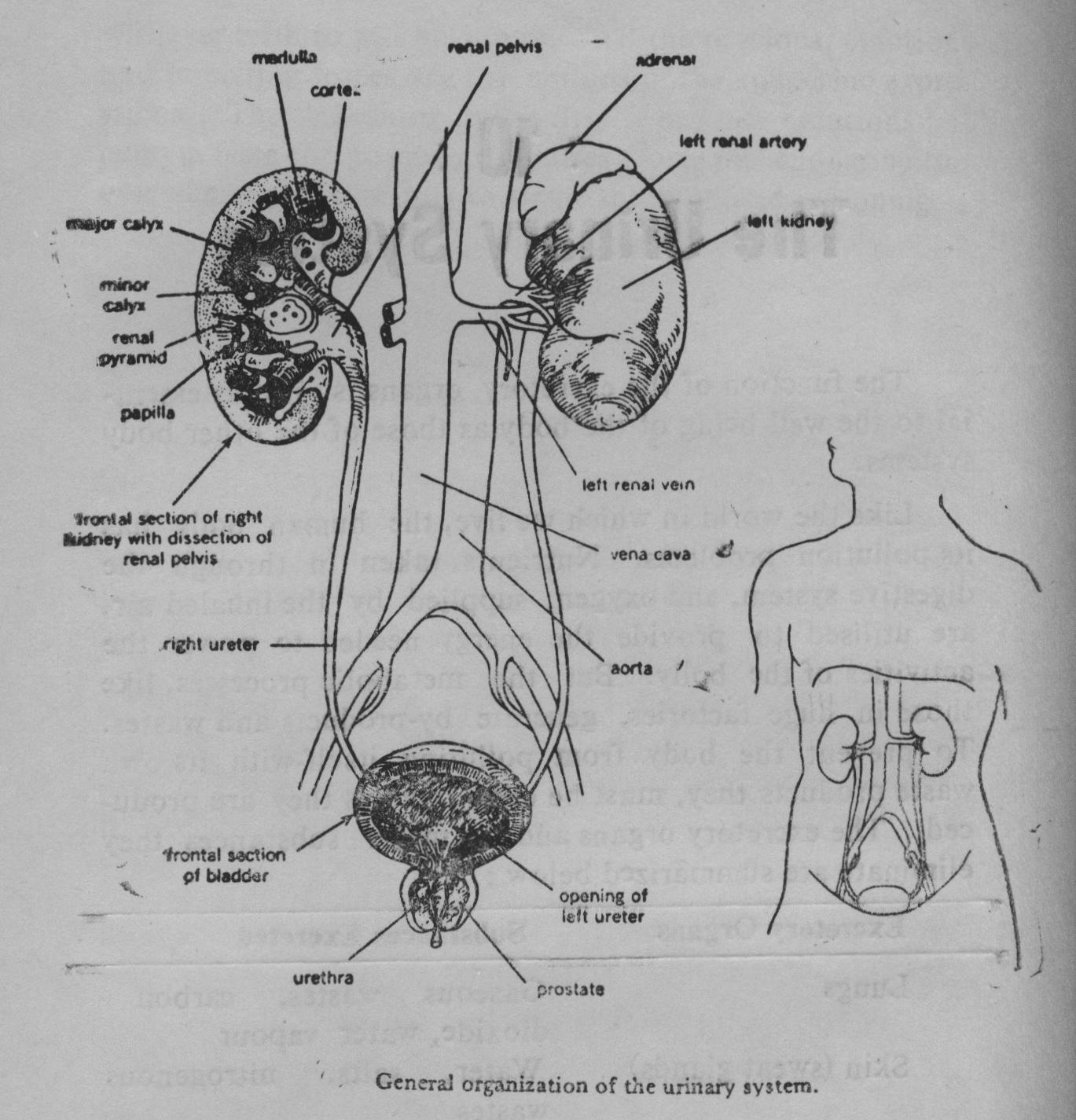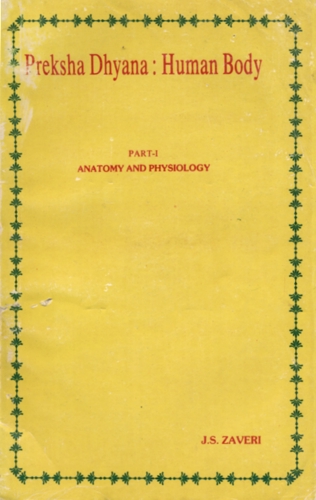The function of the excretory organs is just as essential to the well-being of the body as those of the other body systems.
Like the world in which we live, the human body has its pollution problems. Nutrients, taken in through the digestive system, and oxygen, supplied by the inhaled air, are utilised to provide the energy needed to power the activities of the body. But the metabolic processes, like those in huge factories, generate by-products and wastes. To prevent the body from polluting itself-with its own waste products they, must be eliminated as they are produced. The excretory organs and the major substances they eliminate are summarized below:
Excretory Organs | Substances Excreted |
|---|---|
Lungs | Gaseous wastes, carbon dioxide, water vapour |
Skin (sweat glands) | Water, salts, nitrogenous wastes |
Alimentary canal (large intestine) | Solid wastes of digestion |
Kidneys | Water, nitrogenous wastes. soluble salts, bacterial toxins, infested drugs and poisons, etc. |
We have already dealt with the excretory functions of the lungs, skin, and large intestine. We shall, therefore, discuss here the kidneys together with the other organs of the urinary system. The alimentary canal is not the main waste disposal system, but the urinary system is. The former may become inactive for quite some time without any grave danger, but if the latter closes down, it may spell disaster.

Urine is produced in the kidneys. A pair of narrow tubes, the ureters, carry it from the kidneys to the baglike bladder, in which it is stored temporarily. A single muscular tube, the urethra, leads to the exterior.
Organs of Urinary System
The Kidneys: The major excretory organs for the elimination of nitrogenous wastes are the kidneys. A pair of bean-shaped organs, they are among the hardest working organs in the body. The normal adult kidney is about 10 to 12 cms. long, 5 to 6 cms. wide and about 3 to 4 cms. thick. They are located under the diaphragm, just above the waist line, one on each side of the spine against the posterior body wall. They are embedded in a heavy cushion of fat which both protects and supports them. Both kidneys are capped by adrenal glands.
Microscopic examination of the kidney reveals a complex system of tubes, capillaries, arteries and veins, carefully packed together to form approximately one million identical units called nephrons. They are the structural and functional units of the kidney. Being miniaturized chemical filtration plants, they balance the composition of the blood and form urine.
The Ureters: The urine that is formed continuously in each kidney trickles out through the ureters. Each ureter is a long muscular tube, about 25 to 30 cms. long and 4 to 5 cms. in diameter. There are three constricted areas along the course of the ureter. These three bottlenecks have no-particular effect on the flow of the urine, but they may become trouble spots if stones are formed in the kidneys and pass into the ureters. They may become lodged in the narrow portions producing excruciating pain and a blockage of urine flow.
The Bladder: It is an expandable baglike structure, situated mainly in the pelvic cavity. As it fills up, it expands upward into the abdomen. The two ureters enter the bladder and travel for a few centimeters under the bladder wall. This helps to prevent a backflow of urine.
The Urethra: In both sexes, urine is emptied from the bladder through a pencil size tube, the urethra, which emerges at the exterior surface of the body in an opening.
In females, the urethra is a short tube about 2.5 to 3 cms. long. The male urethra takes a much longer, tortuous course. It goes through the prostate gland and has a total length of about 20 cms. It serves the double function of carrying urine as well as seminal fluid. Enlargement of prostate gland (in old people) can restrict the flow of urine making urination difficult and painful.
Urine Composition: Urine is a watery solution of nitrogenous wastes and salts. Usually, it is a transparent liquid of light yellow colour. It is normally 96 % water and 4 % inorganic and organic waste products. Inorganic wastes include sodium chloride and other salts. Organic wastes are urea, uric acid, etc. Urea which is nearly half of all solids is the end product of protein digestion. The average amount of urine excreted daily is 1.5 to 2 litres containing 25 gms. of inorganic and 35 gms. of organic wastes. The amount can. however, vary considerably even under normal conditions and even more in various pathological conditions. Abnormal constituents of urine include glucose, albumin, blood, pus, bile pigments and stones etc. Various poisons, bacterial toxins and drugs are also excreted through urine. Laboratory examination of urine, provides valuable diagnostic indications of the functioning of the body.
The Formation of Urine
Urine is produced continuously, 24 hours a day. It is formed in the kidneys from the copious blood flow that passes through them.
Three processes are employed by the nephrons of the kidney in the production of urine:
- filtration
- reabsorption
- selection.
Filtration
This is a simple physical process. Water, salts and other substances are filtered through the membranes from blood plasma holding back formed elements of the blood and large proteins.
Absorption
Each day, the kidneys filter about 180 litres of fluid (about 18 buckets full). If all this fluid were excreted as urine, there would be a serious loss of valuable materials, apart from the need of replacing, by drinking, about 400 pounds of fluid each day. But urine production is not a simple Alteration process. As the fluid moves into the nephron, water and solutes are transported out and selectively reabsorbed into the circulation
Selection
Finally the process of selection between the unwanted and wanted substances takes place. The unwanted urea and excess materials pass into the collecting duct where they are then known as urine. A certain amount of water is essential to keep all these unwanted substances dissolved and expelled as urine.
Besides water, glucose, vitamins, proteins, amino acids and various inorganic salts are sent back for the body's use. Thus, the fluid that finally trickles down the ureters has a quite different composition from the initial filtrate and the blood from which it was formed. About 1200 ml. of blood (.about one-quarter of the total cardiac output) passes through the kidneys every minute. Out of this, only 1 ml/min. flows into the bladder. Drinking large amounts of liquids results in dilution of plasma and the filtration rate is increased. Dehydration, on the other hand, decreases this rate.
At night, during sleep, under the influence of ADH, the reabsorption of water is greatly increased and smaller amounts of more concentrated urine are produced. As a result, the bladder is usually able to cope with a night's urine production allowing the person to sleep undisturbed. Occasionally, the dissolved salts in the urine may solidify to form kidney stones—either small gritty particles or large stones, which require surgical removal.
Regulation: The organs of urinary system are linked in an effective feedback system with the hypothalamus and pituitary gland. The amount of water excreted by the system is controlled mainly by the hormone ADH (anti-diuretic hormone) produced by the hypothalamus and secreted by the posterior pituitary. In the absence of ADH, the urine output can rise to as high as 15 to 18 ml. per minute; under the influence of the hormone, the urine output may be reduced to 0 35 ml/min. Thus the hypothalamus-pituitary-kidney link maintains a precise balance of the tissue fluids by conserving water for the body and returning the concentration of the fluids to the optimum values.
Urination (Micturition)
Micturition is the act of emptying the bladder or passing the urine. Control over urination is twofold. There is an internal sphincter which is controlled by the autonomic nervous system and has no voluntary control. It is normally in a state of contraction and relaxes when accumulation of urine in the bladder makes voiding necessary. An additional external urethral sphincter permits voluntary control over urination and the voiding reflex can be consciously suppressed. In the very young children, urination is a completely reflex action. Normally in an adult, the presence of about 300 ml. of urine in the bladder will stimulate a desire to urinate, which is primarily a reflex act but the reflex stimulation can be inhibited and urine will continue to accumulate. When the contents reaches a volume of about 700 ml. the average person will have difficulty in controlling the reflex. Emotional stress may prevent the bladder to relax after urination and stimulate an urge to urinate.
Failure of the kidneys can lead to a severe toxic condition called uremia or urine in blood. Toxic wastes build up in the blood and tissues and ultimately poison the body. An artificial kidney utilizing the principle of dialysis can be used to prolong patient's life. Two to three treatments a week are required and each treatment takes five to twelve hours. Home dialysis units are now available.
Besides cleaning and filtering the blood, kidneys encourage production of red blood cells. They regulate the proportion of sodium and potassium salts, water and other substances in the blood. A little too much or a shade too little of any of them can be fatal they control vital water balance. It also keeps blood neither too acidic nor too alkaline.
Thus, kidneys are very discriminating processing plants, carefully regulating our sea of internal fluids. Survival of the whole body relies on the delicate balancing processes of these two organs, no bigger than the size of a clenched fist.
 Jethalal S. Zaveri
Jethalal S. Zaveri

